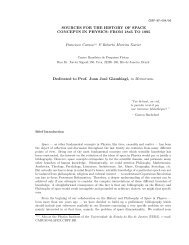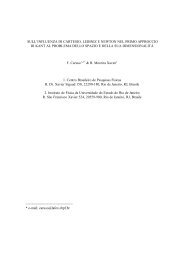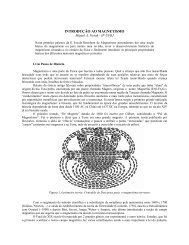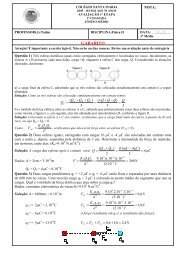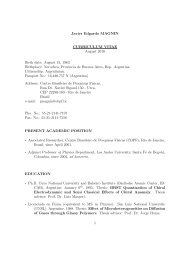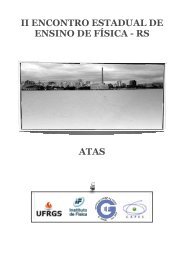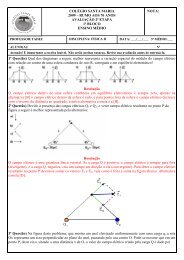Primordial non-Gaussianity in the cosmological perturbations - CBPF
Primordial non-Gaussianity in the cosmological perturbations - CBPF
Primordial non-Gaussianity in the cosmological perturbations - CBPF
Create successful ePaper yourself
Turn your PDF publications into a flip-book with our unique Google optimized e-Paper software.
For this reason, one can use <strong>the</strong> words horizon and Hubble radius <strong>in</strong>terchangeably for standard<br />
cosmology. As we shall see, <strong>in</strong> <strong>in</strong>flationary models <strong>the</strong> horizon and Hubble radius are drastically<br />
different as <strong>the</strong> horizon distance grows exponentially relative to <strong>the</strong> Hubble radius; <strong>in</strong> fact, at <strong>the</strong><br />
end of <strong>in</strong>flation <strong>the</strong>y differ by e N , where N is <strong>the</strong> number of e-folds of <strong>in</strong>flation. The horizon sets<br />
<strong>the</strong> length scale for which two po<strong>in</strong>ts separated by a distance larger than RH(t) <strong>the</strong>y could never<br />
communicate, while <strong>the</strong> Hubble radius sets <strong>the</strong> scale at which <strong>the</strong>se two po<strong>in</strong>ts could not comunicate<br />
at <strong>the</strong> time t.<br />
Note also that a physical length scale λ is with<strong>in</strong> <strong>the</strong> Hubble radius if λ < H −1 . S<strong>in</strong>ce we can<br />
identify <strong>the</strong> length scale λ with its wavenumber k, λ = 2πa/k, we will have <strong>the</strong> follow<strong>in</strong>g rule<br />
k<br />
aH<br />
k<br />
aH<br />
Notice that <strong>in</strong> standard cosmology<br />
≪ 1 =⇒ SCALE λ OUTSIDE THE HORIZON<br />
≫ 1 =⇒ SCALE λ WITHIN THE HORIZON<br />
λ<br />
λ<br />
= = λ H ∼<br />
PARTICLE HORIZON RH<br />
aH<br />
. (142)<br />
k<br />
This shows once more that Hubble radius and particle horizon can be used <strong>in</strong>terchangeably <strong>in</strong><br />
standard cosmology.<br />
5 The shortcom<strong>in</strong>gs of <strong>the</strong> Standard Big-Bang Theory<br />
By now <strong>the</strong> shortcom<strong>in</strong>gs of <strong>the</strong> standard cosmology are well appreciated: <strong>the</strong> horizon or large-scale<br />
smoothness problem; <strong>the</strong> small-scale <strong>in</strong>homogeneity problem (orig<strong>in</strong> of density <strong>perturbations</strong>); and<br />
<strong>the</strong> flatness or oldness problem. We will only briefly review <strong>the</strong>m here. They do not <strong>in</strong>dicate any<br />
logical <strong>in</strong>consistencies of <strong>the</strong> standard cosmology; ra<strong>the</strong>r, that very special <strong>in</strong>itial data seem to be<br />
required for evolution to a universe that is qualitatively similar to ours today. Nor is <strong>in</strong>flation <strong>the</strong><br />
first attempt to address <strong>the</strong>se shortcom<strong>in</strong>gs: over <strong>the</strong> past two decades cosmologists have pondered<br />
this question and proposed alternative solutions. Inflation is a solution based upon well-def<strong>in</strong>ed,<br />
albeit speculative, early universe microphysics describ<strong>in</strong>g <strong>the</strong> post-Planck epoch.<br />
5.1 The Flatness Problem<br />
Let us make a tremendous extrapolation and assume that E<strong>in</strong>ste<strong>in</strong> equations are valid until <strong>the</strong><br />
Plank era, when <strong>the</strong> temperature of <strong>the</strong> universe is TPl ∼∼ 10 19 GeV. From <strong>the</strong> equation for <strong>the</strong><br />
36




